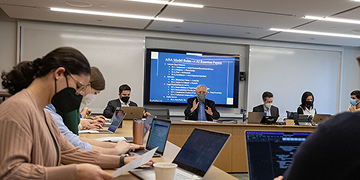Syllo is honored to announce that our lawyer co-founders, Jeffrey Chivers and Theodore Rostow, have authored a chapter in the newly released ABA book, Artificial Intelligence: Legal Issues, Policy, and Practical Strategies. The chapter, titled “Paths to Responsible AI: Reflections from the Classroom,” was co-written with William N. Eskridge, Jr., the Alexander M. Bickel Professor of Public Law at Yale Law School. This publication reflects Syllo’s commitment to contributing to a deeper understanding of AI, not just as a technology, but as a critical component of a modern and responsible legal practice. Jeff and Theo are privileged to be included in a volume with such a collection of expert voices shaping this important dialogue.
The chapter material outlines three core concepts found to be instrumental in the Yale Law classroom to help law students—and legal professionals—begin to think critically about AI in a way that is grounded in the technology; Traditional vs. Machine Learning Programs, Representation of Human Language in Vectors, and Neural Networks.
- Traditional vs. Machine Learning Programs: First distinguishing between traditional software, which follows predictable, human-programmed rules, and machine learning programs, which learn from vast amounts of data. A key difference is that the output of traditional software is predictable, while a machine learning program’s behavior is governed by the mathematical functions it learns. Understanding this difference is crucial for responsibly using generative AI in legal work.
- Representation of Human Language in Vectors: Then exploring how computers process human language. Since computers are math machines, they must convert natural language into a numerical form. Large Language Models (LLMs) do this by using a sequence of numbers called a vector to represent words. This process allows the AI to “read,” “analyze,” and “generate” text through mathematical operations.
- Neural Networks: The third concept describes the software architecture that allows AI to perform complex tasks. These networks are made of many interconnected nodes that perform simple math, but in the aggregate, they embody elaborate mathematical functions. The core mechanism that enables a neural network to perform tasks like summarization is its ability to turn complex language tasks into the simpler, statistical problem of predicting the next word in a sequence.
Jeff and Theo also share their perspectives on how generative AI will change the legal profession, from the day-to-day work of litigators to the broader implications for the legal market and legal education itself. It also emphasizes the heightened need for practical frameworks to evaluate the benefits and risks of AI in legal contexts, a principle that is central to everything we build at Syllo.
The ABA’s publication, Artificial Intelligence: Legal Issues, Policy, and Practical Strategies, Edited by Cynthia H Cwik, Christopher A Suarez, and Lucy L Thomson, is available now in full for purchase.





